Introduction
Understanding the timeline of testosterone treatment is essential for anyone considering this therapy. We understand that embarking on this journey can feel overwhelming, but rest assured, you’re not alone. With personalized approaches gaining traction, many patients find themselves experiencing a range of benefits – from increased energy levels to improved muscle mass – often within just weeks of starting treatment.
However, it’s important to recognize that this journey is not without its complexities. How long does it really take for these effects to manifest fully? What factors can influence this timeline? These are valid questions that many have, and exploring them reveals not only the potential of testosterone therapy but also the importance of tailored care in achieving optimal results.
Together, we can navigate these questions and concerns, ensuring that you feel supported every step of the way. Your wellness journey is unique, and understanding the nuances of testosterone treatment can empower you to make informed decisions.
Woodlands Wellness & Cosmetic Center: Personalized Testosterone Therapy for Optimal Results
At Woodlands Wellness & Cosmetic Center, we understand that hormone treatment is not one-size-fits-all. Each client has unique hormonal needs, and our personalized approach reflects that. Through comprehensive assessments that take into account your age, health status, and lifestyle, we craft care plans tailored just for you. This method is essential for optimizing your treatment’s effectiveness, aligning with the latest advancements in hormone interventions that emphasize customized solutions for better results, including remedies for erectile dysfunction and hormone replacement options.
Studies show that personalized care strategies significantly enhance the effectiveness of testosterone interventions. Clients often report improved energy levels, enhanced sexual function, and increased muscle mass. In fact, many experience remarkable transformations within just weeks of starting their tailored treatment, leading to inquiries about how long does testosterone treatment take to work, and underscoring the importance of a customized approach.
Our specialists in hormone management advocate for these personalized strategies, noting that they not only improve outcomes but also minimize potential side effects. By focusing on your unique needs, Woodlands Wellness & Cosmetic Center ensures a more effective and fulfilling experience, helping you regain your vitality and well-being. As research continues to uncover advancements in male hormone replacement, we remain committed to providing the most current and effective treatment options, including aesthetic procedures that complement our hormone support services.
Together, we can embark on this journey toward better health and wellness. If you’re ready to take the next step, reach out to us today!

Understanding the Timeline: When Do Testosterone Treatment Effects Begin?
Many patients begin to notice positive changes from hormone treatment within just 3 to 6 weeks, prompting them to ask how long does testosterone treatment take to work. At first, you might feel a boost in energy and mood, with many sharing that they experience increased motivation and a sense of overall well-being. Interestingly, some men with low testosterone levels may see reductions in tension, anger, and fatigue as early as Week 2.
However, it’s important to remember that more significant changes, like increased muscle mass and improved libido, raise the question of how long does testosterone treatment take to work, as they typically take a bit longer to fully develop. For example, you might start to notice measurable gains in lean mass and reductions in fat around months 2 to 3. By months 3 to 4, many experience notable changes in body composition, including both lean body mass and fat mass. Many people wonder how long does testosterone treatment take to work, as enhancements in sexual function and strength often become evident by the 3 to 6-month mark.
Understanding how long does testosterone treatment take to work is crucial for your journey. It helps you stay motivated and dedicated to your treatment, ensuring you recognize the gradual yet meaningful benefits of hormone therapy. Together, we can navigate this path towards improved health and well-being.

Maximizing Benefits: Timeframe for Achieving Peak Effects of Testosterone Treatment
If you’re considering testosterone therapy, you might be wondering how long does testosterone treatment take to work and what to expect. Typically, patients can look forward to seeing peak effects and may wonder how long does testosterone treatment take to work, which is usually within 6 to 12 months. During this time, many report significant improvements in muscle strength, fat distribution, and overall vitality. For example, by Month 3, users often notice measurable lean-mass gains and modest fat loss on DEXA scans. Strength and energy levels usually stabilize around Month 6, with most men feeling that the benefits have truly taken hold by week 12.
It’s important to remember that regular follow-ups and potential adjustments to your care plan are essential for maximizing these benefits. If you find that progress seems to stall around weeks 9-10, it may be a good idea to reassess factors like sleep, thyroid function, or micronutrient status. Healthcare providers emphasize that while initial changes can occur within the first few weeks, improvements in libido and sexual function often lead to inquiries about how long does testosterone treatment take to work, as these enhancements typically appear after several months of consistent care.
This structured approach not only helps you achieve your wellness goals effectively but also ensures that you feel supported throughout your journey. Together, we can navigate this path to better health, making adjustments as needed to ensure you’re on track to feeling your best.
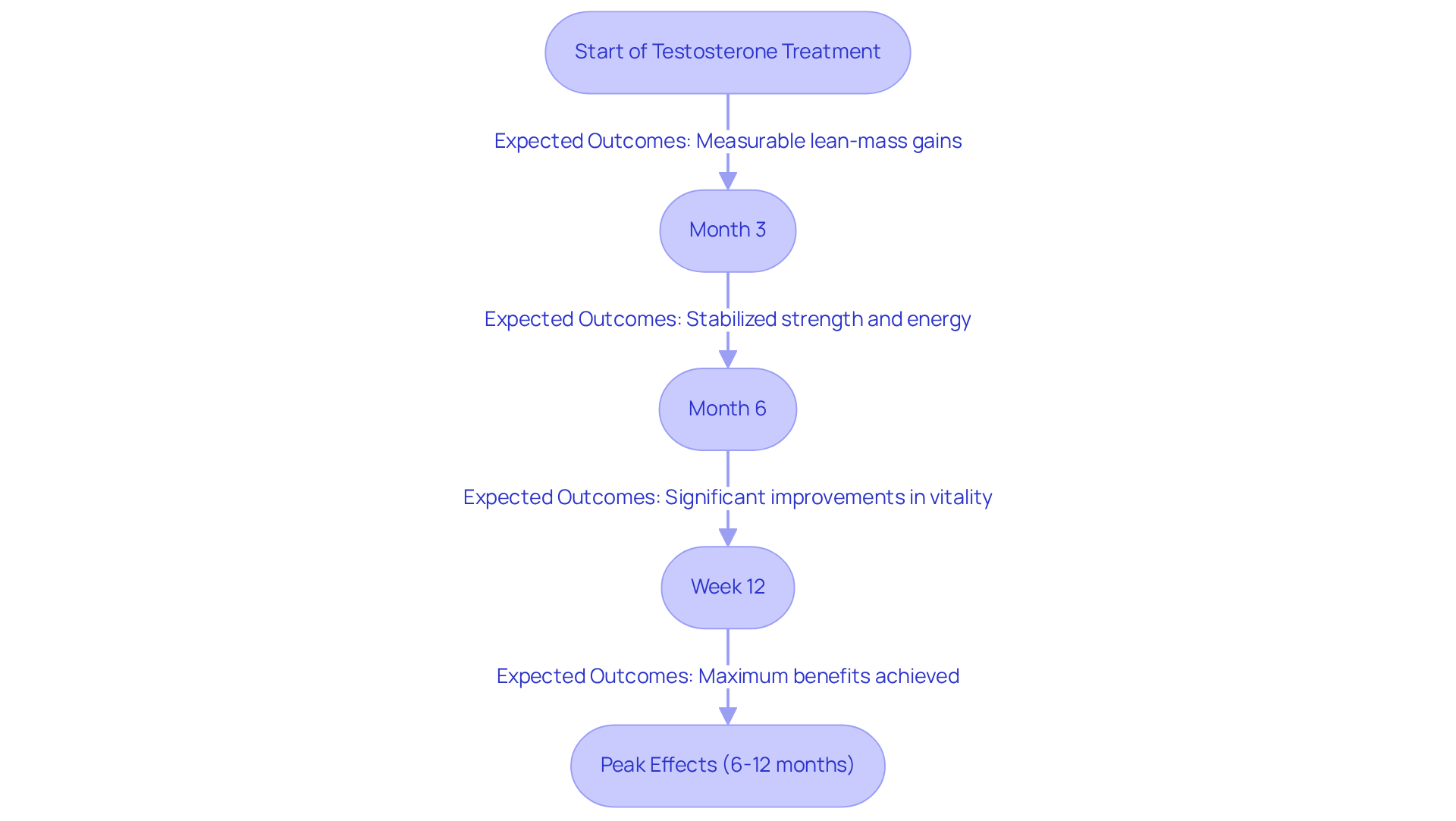
Factors Affecting Duration: What Influences How Long Testosterone Treatment Takes to Work?
Understanding the effects of hormone therapy can feel overwhelming, but it’s essential to recognize that several important factors come into play. Age, baseline hormone levels, overall health, and adherence to the prescribed regimen all influence how long these effects last. For instance, did you know that hormone levels typically decrease by about 1% each year after reaching your 30s or 40s? This gradual decline can affect how long does testosterone treatment take to work before you notice the benefits. Research shows that improvements in muscle mass and strength may become noticeable within 12 to 16 weeks, prompting inquiries about how long does testosterone treatment take to work, with effects stabilizing around 6 to 12 months. Meanwhile, mood changes can often be detected as early as 3 to 6 weeks, leading to questions about how long does testosterone treatment take to work, with effects peaking at 18 to 30 weeks.
Lifestyle choices also play a crucial role in the effectiveness of testosterone therapy. A balanced diet, regular exercise, and effective stress management can significantly enhance your body’s response to treatment. For example, individuals who maintain a healthy lifestyle often report more pronounced improvements in energy levels and overall well-being. On the flip side, factors like obesity, poor sleep, and high stress can hinder the therapy’s effectiveness. This highlights the importance of adopting healthier habits together.
Endocrinologists stress the significance of understanding these variables. As one specialist noted, “The time-course of the hormone’s effects shows considerable variation, likely related to the pharmacodynamics of the hormone preparation.” This insight underscores the need for personalized care plans that consider your unique health profile and lifestyle choices.
Case studies further illustrate these points. One study found that patients who engaged in regular physical activity alongside hormone treatment reported greater improvements in muscle strength and mood compared to those who didn’t. Additionally, changes in lipid profiles were observed after just four weeks of intervention, with peak effects noted after 6 to 12 months. This emphasizes the importance of a comprehensive approach to care.
Ultimately, understanding how age, health, and lifestyle influence hormone therapy can empower you to take an active role in your wellness journey. Together, we can work towards achieving more effective results and enhancing your quality of life.
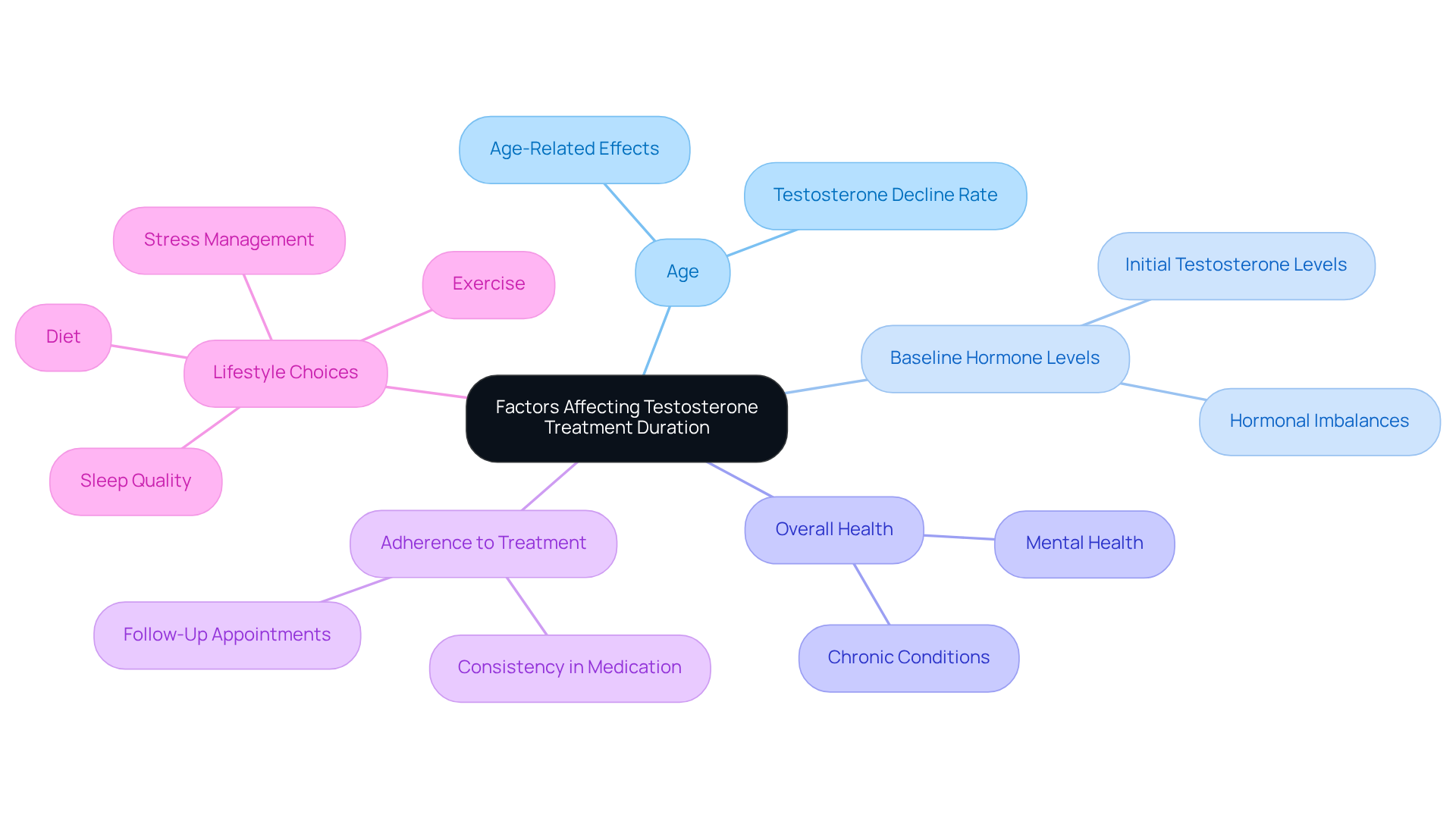
Health Improvements: Key Benefits of Testosterone Treatment Over Time
Over time, hormone therapy can lead to a range of health enhancements that many people find transformative. Imagine feeling more energetic, experiencing an uplifted mood, enjoying a heightened libido, and noticing improvements in muscle mass. At Woodlands Wellness & Cosmetic Center, countless individuals, including long-term patients of Dr. Sakina Davis, share their positive experiences. One client beautifully expressed, “Dr. Davis treats the ‘whole you,’ emphasizing the interconnectedness of health and the importance of balancing hormones to prevent various conditions.”
Furthermore, many patients report not just physical benefits but also improvements in cognitive function and a reduction in symptoms of depression and anxiety. As another satisfied client shared, “The staff at Woodlands Wellness are prompt and professional, ensuring that everything is explained in understandable terms.” These testimonials highlight how hormone therapy can significantly enhance your quality of life.
If you’re facing hormonal imbalances, know that you’re not alone. Together, we can explore how these therapies might be the solution you’ve been seeking. Hormone therapy is more than just a treatment; it’s a pathway to a healthier, happier you.

Monitoring Progress: How to Track the Effects of Testosterone Treatment
Monitoring your progress during hormone therapy is crucial for ensuring its effectiveness. We understand that this journey can come with its own set of challenges. Keeping a journal to record changes in energy, mood, libido, and physical strength can be incredibly helpful. This simple practice not only helps you track your progress but also provides valuable insights to share with your healthcare provider.
Furthermore, regular follow-up appointments are essential. These visits can include blood tests to evaluate your hormone levels and overall health. By staying proactive, you allow for timely modifications to your care plan, optimizing your results. Remember, you’re not alone in this journey; together we can navigate the path to better health.
So, take that step today. Start journaling your experiences and schedule your next appointment. Your health and well-being are worth it!
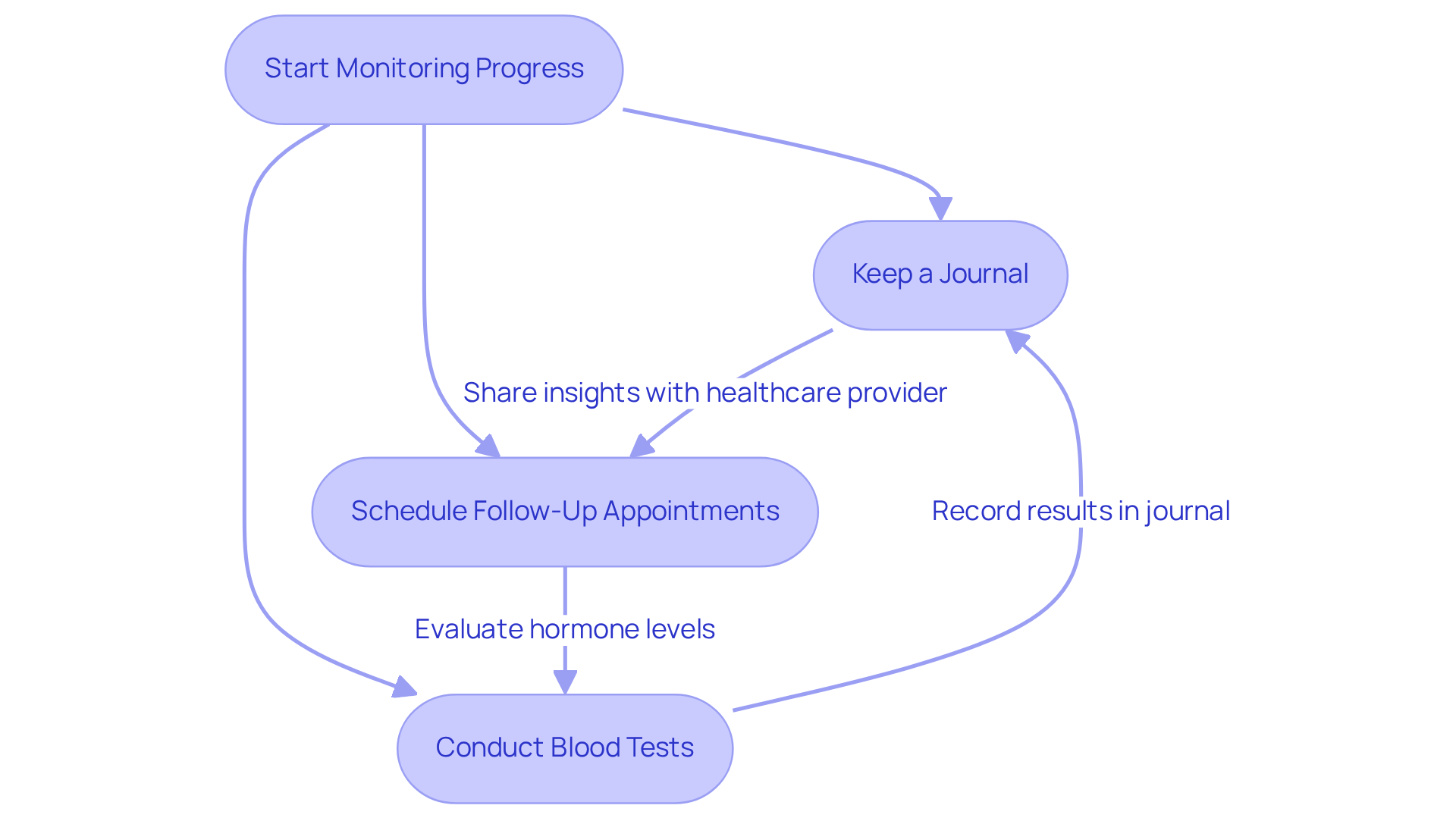
Enhancing Results: Lifestyle Changes to Support Testosterone Treatment
To truly benefit from hormone therapy, it’s important to embrace lifestyle changes that can significantly enhance your treatment outcomes. Have you considered how consistent physical activity, especially resistance training and high-intensity interval workouts (HIIT), can naturally boost your hormone levels and promote your overall well-being? A balanced diet rich in healthy fats, lean proteins, and essential nutrients like zinc and vitamin D is also crucial for hormone production. For example, incorporating foods such as avocados, olive oil, and leafy greens can help maintain hormonal balance and optimize your treatment results.
Another key factor is getting enough sleep. Did you know that hormone production peaks during deep sleep stages? Research indicates that inadequate sleep can reduce hormone levels by as much as 20%. This highlights the importance of establishing a regular sleep routine and creating a restful sleeping environment. Additionally, stress management techniques like mindfulness and yoga can support hormonal balance by lowering cortisol levels, which can negatively impact hormone production.
Many individuals who combine these lifestyle changes with hormone therapy report more significant improvements in their symptoms and overall well-being. For instance, a recent study found that patients who engaged in regular exercise and maintained a nutritious diet achieved normal hormone levels in about 90% of cases. Nutritionists emphasize that a holistic approach – integrating diet, exercise, and stress management – is essential for maximizing the effectiveness of testosterone treatment, particularly in relation to how long does testosterone treatment take to work.
Together, we can take these steps towards a healthier you. By making these changes, you’re not just enhancing your hormone therapy; you’re investing in your overall health and happiness.
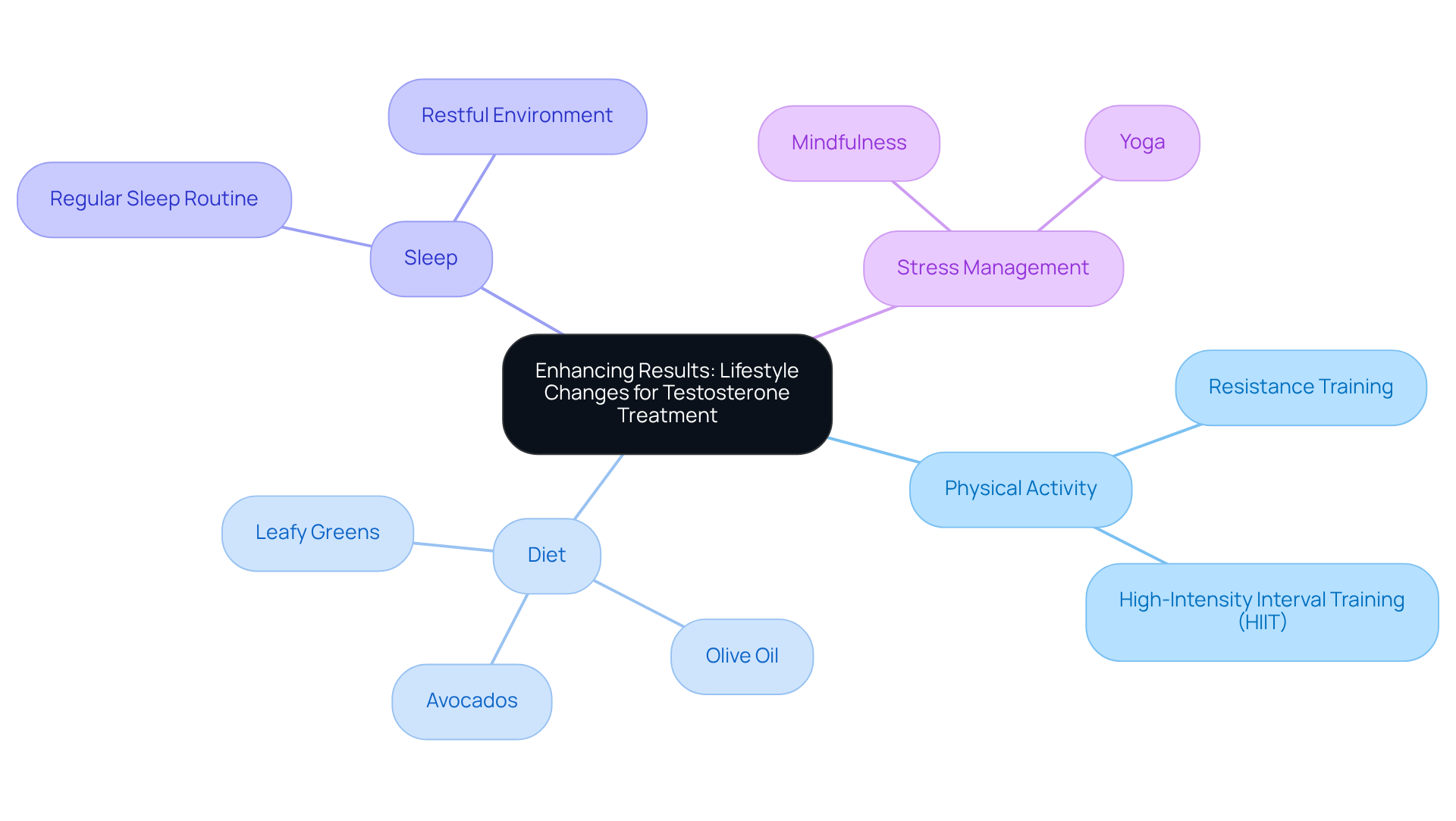
Side Effects Awareness: Understanding the Risks of Testosterone Treatment
Testosterone treatment can offer significant benefits, but it’s crucial to understand the associated risks. Many clients may experience side effects like acne, increased body hair, mood swings, and changes in cholesterol levels. In fact, research indicates that nearly half of patients undergoing hormone treatment report side effects, particularly in studies involving direct-to-consumer clinics, where almost 90 percent lacked an endocrinologist or urologist on staff. This highlights the need for vigilance and proper medical oversight.
Furthermore, regular evaluation of hormone levels and health indicators is essential. Testosterone can exacerbate conditions such as sleep apnea and may lead to cardiovascular issues for some individuals. Notably, the warning about cardiovascular risks was lifted earlier this year following the TRAVERSE trial, adding important context to the ongoing discussion about these risks. Open communication with healthcare providers is vital for effectively managing these concerns.
Doctors typically recommend assessing hormone levels at least twice before starting treatment, and ongoing evaluations are key to tailoring care to individual needs. Experts emphasize that a thorough review of both lab results and patient symptoms is crucial in determining the appropriateness of hormone therapy. For instance, consider the case of a 72-year-old man who experienced significant improvements in strength and endurance after a year of treatment, yet faced challenges that required careful management of his care.
Additionally, it’s important to note that hormone replacement therapy can cost around $100 to $150 a month, which is a significant consideration for many clients. Medical professionals caution against self-administering hormones without proper supervision, as this can lead to dependency and other health complications. As urologist Larry Lipshultz points out, a comprehensive approach that considers both symptoms and lab values is essential for safe and effective care.
By prioritizing patient education and proactive management, we can navigate the complexities of hormone treatment together, minimizing potential risks and fostering a supportive environment for all.

Psychological Impact: How Testosterone Treatment Affects Mental Well-Being
Testosterone treatment can significantly enhance mental well-being, and many clients find themselves experiencing notable improvements in mood, reduced anxiety, and enhanced cognitive function. Have you ever felt like your emotional state is out of balance? Research suggests that nearly half of women receiving low-dose hormone treatment reported:
- Enhanced mood (47%)
- Improved cognitive clarity (39%)
- Increased libido (52%)
These findings indicate that hormone treatment can effectively address gaps in traditional hormone replacement plans, especially for those facing emotional fluctuations linked to hormonal imbalances.
Furthermore, case studies have shown that hormone replacement treatment for men diagnosed with hypogonadism led to significant enhancements in mood and energy levels. Participants in these studies often share how they feel more youthful and motivated, highlighting the therapy’s potential to improve overall quality of life. Imagine waking up each day feeling energized and ready to take on the world.
Expert opinions further support the idea that this hormone plays a vital role in brain health, challenging outdated assumptions that it is solely a ‘male hormone.’ When used appropriately, this hormone can be a powerful tool, not just for sexual wellness but also for emotional and cognitive vitality. This holistic approach emphasizes the importance of personalized support and continuous observation to ensure safety and effectiveness. Together, we can empower you to achieve a balanced and fulfilling life.
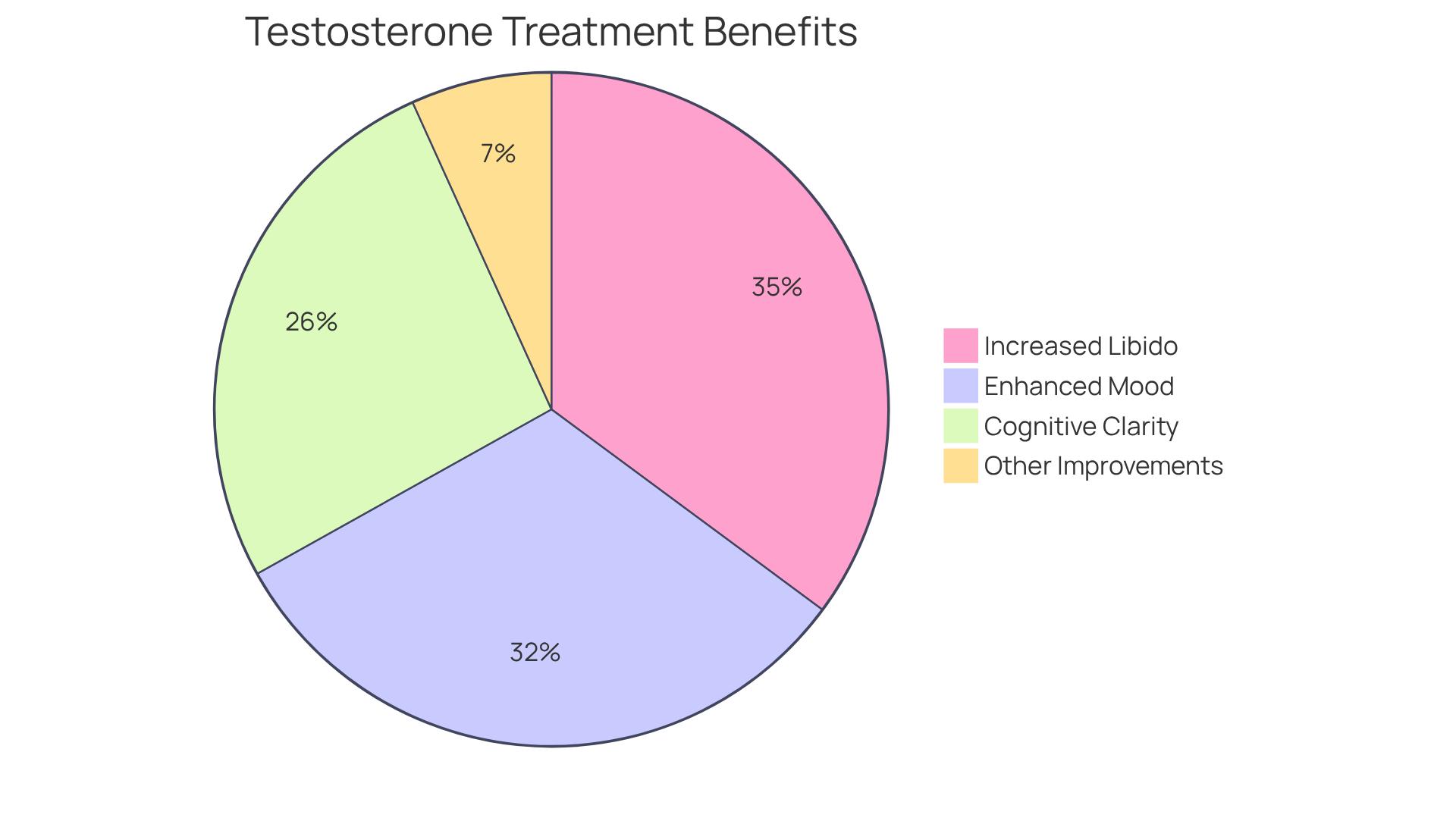
Long-Term Considerations: What to Expect After Completing Testosterone Treatment
After completing testosterone treatment, many individuals notice a gradual decline in hormone levels back to their baseline. We understand that this can be concerning, but adopting a healthy lifestyle and engaging in regular health monitoring can help preserve the benefits gained during treatment. Routine check-ups with healthcare providers are essential; they can address any recurring symptoms and support your ongoing wellness. By taking a proactive approach to your health, you can maintain the positive changes you’ve experienced.
Research shows that a balanced diet, regular exercise, and effective stress management can significantly enhance the long-term effects of hormone therapy. For instance, one patient shared how, after finishing his hormone treatment, he successfully sustained his improved energy and mood by following a low-carbohydrate, high-fat diet and incorporating regular exercise into his routine. This kind of commitment can make a real difference.
Healthcare professionals emphasize the importance of staying engaged in health-promoting activities after treatment. Experts agree that committing to lifestyle changes can lead to sustained improvements in overall health and well-being. This proactive approach not only helps manage any potential return of symptoms but also contributes to long-term vitality and quality of life.
Dr. Prediman K. Shah, a cardiologist, reassures us that “when patients exhibit signs of low hormone levels, physicians can feel more at ease that prescribing hormone supplements to maintain normal physiological levels does not come with a significant liability.” Furthermore, a significant study released in 2023 monitored over 5,200 men aged 45 to 80, indicating no heightened cardiovascular risk from hormone treatment compared to placebo. However, it’s important to note that there was a slight increase in atrial fibrillation risk among men receiving testosterone therapy, which highlights the need for open discussions with doctors for those who may have concerns. Therefore, ongoing health monitoring remains crucial.
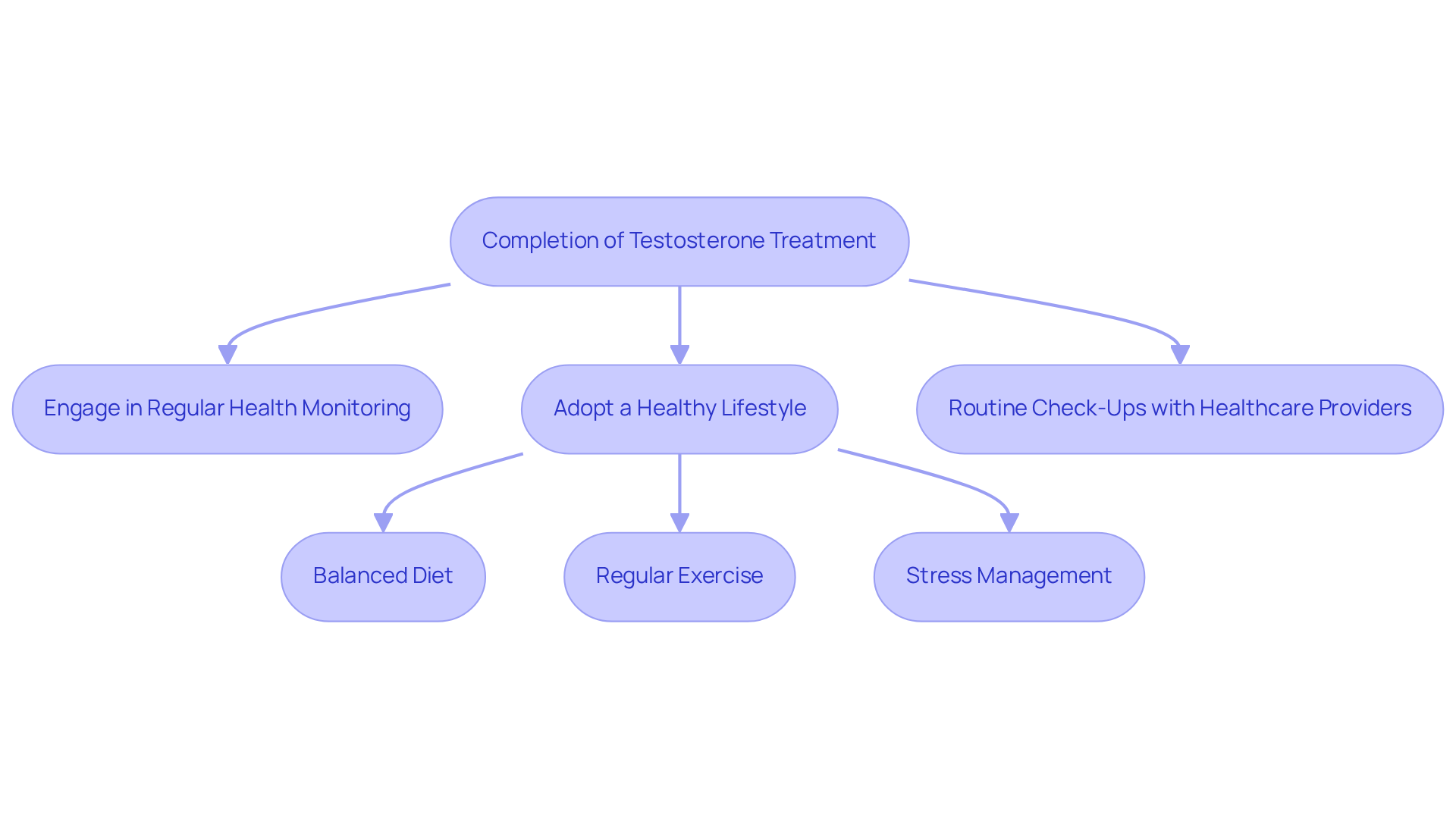
Conclusion
Understanding the timeline and effects of testosterone treatment is crucial for anyone considering this therapy. We recognize that each individual’s journey is unique, influenced by factors like age, health, and lifestyle. By tailoring care plans to meet specific needs, you can experience significant improvements in energy, mood, and overall health, often within just weeks of starting therapy.
Initial benefits may show up within a few weeks, while more substantial changes, such as increased muscle mass and improved libido, typically develop over several months. Regular monitoring and lifestyle adjustments, including exercise and diet, are vital for maximizing these results. Furthermore, being aware of potential side effects and maintaining open communication with your healthcare provider is essential for ensuring a safe and effective treatment experience.
Ultimately, embracing a holistic approach to testosterone therapy-one that includes personalized care, proactive health monitoring, and lifestyle changes-can lead to transformative health benefits. For those ready to embark on this journey, taking the first step towards improved well-being not only enhances the effectiveness of the treatment but also fosters a healthier, more fulfilling life. Together, we can navigate this path to better health.
Frequently Asked Questions
What is the approach taken by Woodlands Wellness & Cosmetic Center for testosterone therapy?
Woodlands Wellness & Cosmetic Center utilizes a personalized approach to testosterone therapy, crafting care plans based on comprehensive assessments of each client’s age, health status, and lifestyle to optimize treatment effectiveness.
How quickly can clients expect to see results from testosterone treatment?
Clients may begin to notice positive changes within just 3 to 6 weeks, with improvements in energy, mood, and motivation. More significant changes, such as increased muscle mass and improved libido, typically take longer, often becoming evident by the 3 to 6-month mark.
What are some of the benefits reported by clients undergoing personalized testosterone therapy?
Clients often report improved energy levels, enhanced sexual function, increased muscle mass, and reductions in tension, anger, and fatigue.
How long does it take to achieve peak effects from testosterone treatment?
Peak effects from testosterone treatment are typically observed within 6 to 12 months, with significant improvements in muscle strength, fat distribution, and overall vitality reported during this timeframe.
What should clients do if they notice a stall in their progress during treatment?
If progress seems to stall around weeks 9-10, it is advisable to reassess factors such as sleep, thyroid function, or micronutrient status, and consider regular follow-ups with healthcare providers for potential adjustments to the care plan.
How does personalized care impact the effectiveness of testosterone interventions?
Personalized care strategies significantly enhance the effectiveness of testosterone interventions by aligning treatment with individual needs, which also helps to minimize potential side effects.
What additional services does Woodlands Wellness & Cosmetic Center offer alongside testosterone therapy?
In addition to hormone therapy, Woodlands Wellness & Cosmetic Center provides aesthetic procedures that complement their hormone support services.









